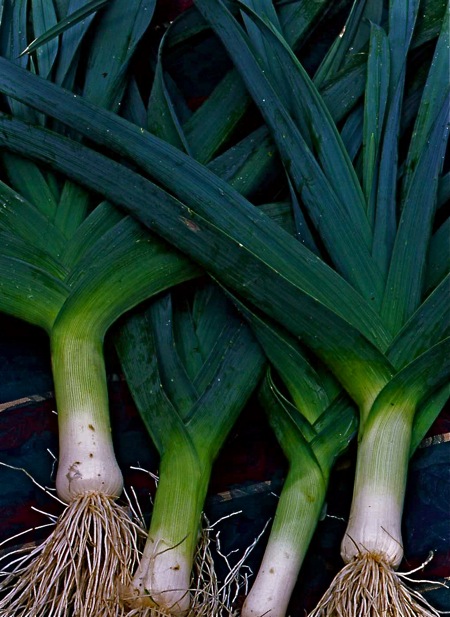The Love of Leeks….and dairy free Mashed Potatoes
This is part one of a Love Story of Leeks.
I sometimes refer to my Helpers, my crew, the band of ingredients that are my secret weapons. Friends I can turn to when something isn’t right—if a sauce is bland, or too bright, or if it has no base flavor—I consult my arsenal of Superheroes. I have a page with the Helpers List but they need more explanation. Just like the DC Comics making the movies of the individual superheroes before introducing The Avengers as a group, I’ll try and take these one at a time.
The Lovely Leek has at least two Superpowers.
Flavor is the first Superpower.
It will make everything savory taste better. My friend Don used to say that butter made everything better, but I would say the same for leeks. It is of the onion family so it increases the base and provides depth to whatever you are making.
Creamy mouthfeel is the second Superpower.
Mouthfeel. A consistency that, when just right, can induce swooning. Sometimes our cravings are not just for a flavor, but a texture on the tongue. Pureed leeks make the leap from being a vegetable to magically transforming into cream and butter. Transmutation or something beyond my science, your tongue may be fooled that this light green froth came from the udder of somebody’s mudder.
.
Ways to use leeks
- In soups, especially pureed ones
- In gratins and casseroles
- With roasted vegetables
- In pasta sauces, both tomato based and cream based
- Braised with chicken stock or butter with parmesan on top
- In frittata or quiche
.
Here are a couple of sites: Simple Bites gives a few preperation tips, and World’s Healthiest Foods has more information than you’ll want.
.
I could gush on, but now it’s on to the potatoes….
.
Rules of Thumb for Mashed Potatoes
- Russets have the most starch and make the fluffiest mashed potatoes. Yukon Golds are second on the list. Potatoes that are low in starch (like reds and blues) are better for making roasted potatoes.
- The more contact a potato has with water, the more water it will absorb—and it will absorb less of the tasty ingredients like cream or butter.
- Because russets absorb more water they say russets are better for baking and Yukon Golds are better for boiling. I understand the rule, but don’t always follow it…I’ve boiled many a russet.
- Make them last, right before the meal.
- Keep them warm with indirect or gentle heat. If you must hold them, put them on the top of a double boiler or in the oven in a heavy crock. Once they cool down their consistency changes.
- Anything that is added should be warm or at least room temperature (milk, butter, leeks, etc). You do not want to cool the potatoes!
- Over mixing will cause them to become gluey. Never use a food processor. I prefer a hand masher with holes or a food-mill/ricer.
Then the Two become One.
.
.
Green Goo from an alien invasion?? Bizarre looking though it may be, it’s tasty.
Adding the pureed leeks to mashed potatoes helps them feel creamy without the cream so my dairy free friends can carbo-load along with the rest of us. Don’t stop here—try the leek puree in soups and sauces. Use it like a cream sauce and see what happens.
.
.
Nutritional yeast adds a base flavor that gives it a buttery-ness, and boosts the protein and B vitamin content. It’s another of my Superhero Helpers.
I also love to add roasted garlic to all mashed potatoes, here is a method from The Hungry Mouse. I usually turn the heads face down and add a little water with the oil in the pan, but I guess I’ll have to show that method in another post…
.
Another use
I recently made this little potato mixture then added extra nutritional yeast and used it as a layer in a dairy free enchilada pie. When baked into the the pie it had a similar flavor and consistency to a fresh cheese.
.
Dairy Free Mashed Potatoes
Prep Time: 15 minutes Bake Time: 60-90 minutes
Gather your ingredients ahead of time so you can move quickly once the potatoes are done.
Baking Method
Bake at 400 degrees at least 1 hour or until very soft:
4 or 5 Russets
When fully cooked, remove from oven one at a time.
Slice in half. Holding one half in a towel in your hand, scoop out the contents into a warm bowl.
Repeat with all of the potatoes.
Boiling Method
Quarter and add to a stock pot with enough water to cover:
4 or 5 Yukon Gold Potatoes or Russets (I usually peel russets but not the Golds…as long as they’re organic)
Boil until soft, then drain.
Prep the Leeks
While the potatoes are cooking, wash and coarsely chop:
1 medium Leek, around 1 cup (the white and light green parts only)
Add leeks to a sauce pan with:
around 1 cup Stock or Water
Salt and Pepper
Cover and simmer until the leeks are very soft.
Puree the cooked leeks in a food processor until frothy—you may need to add a little water so the leeks can blend well.
If the leeks are prepped ahead of time, heat them before adding to the potatoes.
Finish it
When potatoes are done, mash them with a hand-masher or a food mill. Heat the pan they are mixed in or keep them as warm as possible.
Add:
the Leeks, pureed and warm
1 -2 Tablespoons Olive Oil
1 teaspoon Nutritional Yeast
1-2 cloves Roasted Garlic
Salt and Pepper to taste
Mix everything together.
Taste and adjust—I never measure when making mashed potatoes…tasting is the best way to go
Eat right away or cover and keep warm in the oven or in a double boiler.
.



